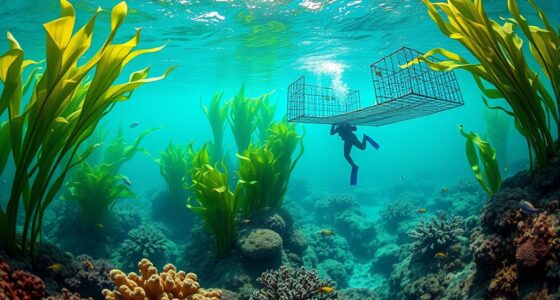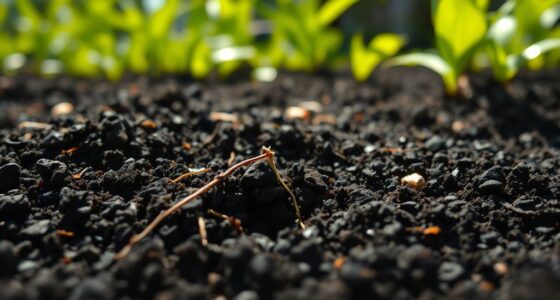Kite power generators harness high-altitude winds, which are stronger and more reliable than those closer to the ground. These systems use innovative kite designs, like traction kites or aerodynamic wings, tethered to ground-based turbines. As the kite moves with the wind, it pulls on the tether, generating electricity efficiently. This technology offers a clean, sustainable energy source with great potential for the future—discover how these systems work and why they matter.
Key Takeaways
- Kite power generators utilize high-altitude winds, which are stronger and more consistent than ground-level winds, for efficient energy production.
- These systems employ aerodynamic wings or kites that generate lift and tension, driving ground-based turbines or tethered power devices.
- High-altitude wind harnessing benefits from stable atmospheric conditions, reducing turbulence and increasing system reliability.
- Advanced control and tether materials enable safe operation and effective energy conversion from high-altitude wind flows.
- Kite power technology offers a renewable, scalable solution to expand clean energy access and reduce reliance on fossil fuels.
The Science Behind High-Altitude Wind Capture

High-altitude winds are stronger and more consistent than those near the ground, making them an ideal energy source. Wind shear, which is the change in wind speed and direction at different altitudes, plays a vital role in harnessing these winds. By capturing the wind where shear is most significant, kite systems can generate more power efficiently. Atmospheric stability also influences wind flow; stable conditions keep the wind steady, reducing fluctuations that could disrupt energy production. When the atmosphere remains stable, wind patterns stay predictable, allowing you to optimize kite altitude for maximum energy capture. Understanding these atmospheric factors helps you design better systems that tap into high-altitude winds, providing a reliable, renewable energy source with consistent power output. Additionally, knowledge of wind speed and variation is crucial for improving the efficiency and reliability of kite power generators.
Types of Kite Power Systems and Their Mechanics

You’ll find that different kite power systems use various designs to generate electricity efficiently. Traction kite systems, tethered power generators, and aerodynamic wing designs each have unique mechanics and advantages. Understanding how these types work helps you see which might be best suited for different applications. Additionally, the efficiency of these systems can be influenced by fetal movement patterns, which are important in assessing overall system performance.
Traction Kite Systems
Traction kite systems harness wind energy by using kites or wings that generate lift and pull on tethers connected to ground-based generators. These systems rely heavily on kite agility to adapt to changing wind conditions and maximize efficiency. Accurate wind forecasting helps you position and control the kites for ideal power generation. Different types include soft kites, rigid wings, and hybrid designs, each suited for specific conditions. The mechanics involve controlling the kite’s angle of attack and tether tension to maintain steady pull. Proper calibration and understanding of color accuracy can also enhance the effectiveness of visual monitoring systems in kite control setups. Here’s a quick overview:
| Type | Control Method | Suitable Conditions |
|---|---|---|
| Soft Kites | Bridle and steering | Variable, gusty winds |
| Rigid Wings | Aeroelastic control | Consistent high winds |
| Hybrid Systems | Combination control | Versatile environments |
Tethered Power Generators
What types of tethered power generators make kite energy practical, and how do they work? These systems use different tether designs to convert high-altitude wind energy into electricity. They often employ durable tether materials like carbon fiber or high-strength synthetic fibers to withstand tension and environmental stress. The mechanics involve the kite flying in a crosswind pattern, generating lift and power through onboard turbines or ground-based generators linked by the tether. Safety protocols are essential to prevent accidents, including regular tether inspections and automated shutdown systems. To deepen your understanding, consider these aspects: tether material strength and how it impacts system reliability, the role of safety protocols in mitigating operational risks, and the differences between fixed and movable tether configurations.
Aerodynamic Wing Designs
Different aerodynamic wing designs markedly influence the efficiency and stability of kite power systems. By focusing on aerodynamic optimization, you can enhance lift, reduce drag, and improve energy generation. Variations like delta, box, and cellular wings each offer unique advantages depending on wind conditions and system goals. Choosing the right wing materials, such as lightweight composites or durable fabrics, guarantees longevity and responsiveness. These materials help your kite maintain shape and performance under high-altitude stresses. The mechanics of each design affect how smoothly your kite can adapt to changing winds, maximizing energy output and minimizing turbulence. Additionally, understanding the aerodynamic principles involved can help in designing wings that are better suited for specific wind profiles. Ultimately, understanding these aerodynamic principles enables you to select or customize wing designs that optimize power generation while maintaining stability in diverse high-altitude environments.
Advantages of Using Elevated Wind Resources

Using elevated wind resources gives you access to stronger, more consistent winds that can generate more power. This means your kite system can produce electricity more reliably and efficiently. As a result, you can extend energy access to areas that previously had limited or no wind power options. Airless spray technology enhances application precision, just as harnessing high-altitude winds maximizes energy output efficiency.
Stronger Wind Strengths
Elevated wind resources offer considerably stronger and more consistent winds than those closer to the ground, making them ideal for maximizing energy production. At higher altitudes, wind shear causes faster and steadier airflow, increasing the energy you can harness. Because atmospheric turbulence is less intense aloft, your kite power generator faces fewer disruptions, leading to more reliable operation. The increased wind strength means you can generate more power with smaller equipment, optimizing efficiency. Additionally, the consistent high-altitude winds reduce variability, helping stabilize energy output. This stability is vital for integrating renewable energy into the grid. Overall, harnessing these stronger winds allows for better performance, higher capacity factors, and a more dependable energy source.
- Greater wind shear at high altitudes enhances energy extraction
- Reduced atmospheric turbulence leads to smoother operations
- Stronger winds enable smaller, more efficient turbines
- Tuning upgrades can further improve system efficiency and durability
Extended Energy Access
By harnessing the stronger and more consistent winds at higher altitudes, you can substantially expand your energy access beyond traditional ground-based sources. Elevated wind resources enable you to generate power in areas with limited or unreliable ground winds, improving overall energy availability. This expanded access supports solar integration by providing a steady backup when sunlight wanes, ensuring continuous power supply. Additionally, kite power systems contribute to grid stability, as their predictable high-altitude winds help smooth out fluctuations in energy production. You can therefore reduce dependence on fossil fuels and enhance energy resilience. Incorporating renewable energy sources can boost overall system efficiency and sustainability. This approach opens new opportunities for remote communities and urban centers alike, making clean, reliable energy more accessible and fostering a more sustainable energy future.
Technological Challenges and Solutions

What are the main technological hurdles facing kite power generators today? Achieving wind stability is a critical challenge, as high-altitude winds can be unpredictable and turbulent. Maintaining consistent tension on the kite’s tether requires advanced control systems. Material durability is also essential; the materials must withstand extreme weather, UV exposure, and repetitive stress. Additionally, efficient energy conversion and safe landings pose ongoing difficulties. Recognizing patterns in angel numbers can provide insights into optimal timing for deploying new technologies and solutions.
Real-World Applications and Pilot Projects

Recent pilot projects demonstrate that kite power generators are shifting from experimental setups to practical solutions. They’re being tested in real-world environments, gaining attention from communities and regulators alike. Successful projects involve community engagement to address local concerns and foster support. Regulatory policies are evolving to accommodate these new technologies, ensuring safety and environmental standards. As these initiatives advance, they highlight the importance of regulatory frameworks in facilitating sustainable energy innovations.
Future Prospects and Environmental Impact

As kite power technology advances, its future prospects look promising for expanding renewable energy sources and reducing reliance on fossil fuels. You can expect increased investments as policymakers recognize its potential, but policy implications will influence deployment speed and scale. The economic feasibility of kite power depends on reducing manufacturing and maintenance costs, making it competitive with traditional energy sources. Environmental impacts are generally positive, as kite turbines produce minimal land use and low emissions. However, you should consider potential risks to wildlife and air traffic. To harness full potential, ongoing research must address technical challenges, regulatory frameworks, and public acceptance. Ultimately, kite power could become a significant player in sustainable energy portfolios, contributing to a cleaner, greener future.
Frequently Asked Questions
How Do Kite Power Generators Compare Cost-Wise to Traditional Wind Turbines?
You might wonder about the cost comparison between kite power generators and traditional wind turbines. Generally, kite systems can be more cost-effective because they require less material, easier installation, and lower maintenance. This improves their economic viability, especially in remote areas or offshore. While initial investments vary, many see kite power as a promising, affordable alternative that could reduce energy costs over time.
What Are the Safety Concerns Associated With High-Altitude Kite Systems?
Think of high-altitude kite systems as aerial dance partners; they face risks like lightning strikes that can cause sparks and damage, much like a sudden storm. Bird collisions are another concern, risking harm to avian visitors. You need to contemplate these safety issues carefully, ensuring proper design and monitoring. By addressing these hazards, you can keep your kite system dancing safely and sustainably in the sky.
Can Kite Power Technology Operate Effectively in All Geographic Locations?
You might wonder if kite power technology can work everywhere. Geographical limitations and climate dependencies play a big role in its effectiveness. In areas with steady high-altitude winds, it performs well. But in locations with unpredictable weather or low wind speeds, its efficiency drops. So, you’ll need to assess local wind patterns and climate conditions to determine if kite power is a suitable energy solution for a specific region.
How Is the Energy From Kite Systems Integrated Into Existing Power Grids?
You’re about to find out how energy from kite systems gets into the grid, and it’s not as simple as flipping a switch. First, the system connects through grid interconnection points, allowing seamless transfer. Then, energy storage plays a role in balancing supply and demand. This integration requires sophisticated control systems to guarantee stability, making sure the power flows smoothly without causing disruptions to your local grid.
What Regulations Govern the Deployment of High-Altitude Wind Harvesting Devices?
You need to understand that deploying high-altitude wind harvesting devices involves strict airspace regulations to guarantee safety and avoid conflicts with aviation. These regulations also address environmental impact, requiring thorough assessments to minimize disturbances to wildlife and ecosystems. Before installation, you should coordinate with authorities, obtain necessary permits, and adhere to guidelines that balance innovative energy generation with safety and environmental protection.
Conclusion
Imagine a future where kite power generators unleash limitless, unstoppable energy from the skies, transforming our world into an endless paradise of clean, free electricity. With high-altitude winds harnessed effortlessly, you’ll witness a revolution so powerful it’ll erase energy fears forever. This isn’t just innovation—it’s a seismic shift that will elevate humanity into a new era of unstoppable progress and environmental salvation. Get ready, because the sky’s the limit, and we’re just beginning!










